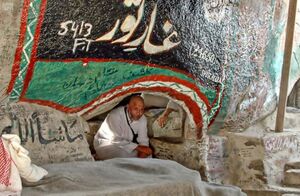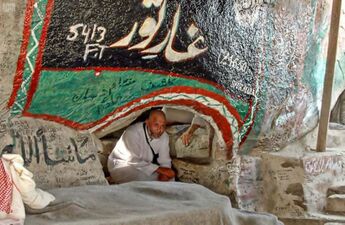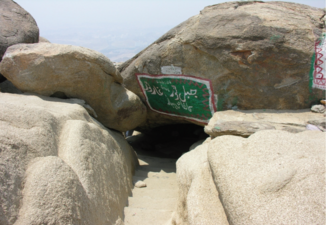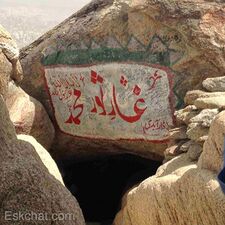Thawr Cave
 | |
Thawr Cave is a cave located on Mount Thawr in the south of Mecca. This cave is the place where the Prophet (PBUH) sought refuge during the migration to Medina."
Hiding of the Prophet (PBUH)
The significance of Mount Thawr lies in the fact that the Prophet (PBUH), during the migration to Yathrib, concealed himself in a cave atop this mountain for three days. The polytheists, utilizing skilled trackers such as Kurz bin Alqamah, pursued him and traced his footsteps to the entrance of Thawr Cave. The nesting of birds, the weaving of spider webs, or the growth of a short-lived plant at the cave's entrance left the polytheists discouraged in their search for the Prophet. After a three-day stay in this cave, the prophet (PBUH) continued his journey to Yathrib.[1] Apparently, the passage along the route chosen by the Prophet (PBUH) for ascending the mountain during the migration posed difficulties, leading to bleeding in his feet during the ascent.[2]
Location
At the summit of Mount Thawr, there are two adjacent caves, both considered hiding places of the Prophet (PBUH) during the migration to Yathrib (Medina). Considering the companionship of Abu Bakr and also Amer bin Fuhayrah, the guide of the route, it can be said that the larger cave served as the place of concealment. The dimensions of this cave are 5.3 square meters in length and width, with a height of 1.3 meters.[3] Verse 40 of Surah At-Tawbah, in which Allah reports about the support of the Prophet and his companion, refers to this event and the cave.[4]
Visit to Thawr Cave
Thawr Cave has always been a focal point for Muslims, and many individuals throughout different periods have ascended the mountain to see it.[5] "Apparently, in the 14th century AH (20th century CE), it was customary for the people of Mecca to visit this mountain on Saturdays, while the rest of the days were for others to visit.[6] At that time, stone markers were placed along the path and on top of the mountain to guide visitors.[7]
Changes to the Cave Entrance
Kurdi (d. 1400 AH/ 1979-80) claimed, referring to a phrase from the Qamus al-Muhit and Abu Bakr's account of staying in the cave, that the entrance to the cave was originally at its upper section during the Prophet's time and that the current entrances were later created.[8]
Ibn Jubayr (d. 612 AH/1215-6) mentioned two entrances for the cave, with one of them being wider, and people mostly used that entrance to access the cave.[9] Based on this report, apparently, during those periods, the second entrance was created for the easy access of pilgrims to the cave. This was because the main opening of the cave, which was located on the Qibla side, was very narrow, requiring a specific skill to pass through. Around the year 800 AH/1397-8, the main entrance of the cave was slightly expanded by cutting rocks.[10]
"Nevertheless, subsequent reports still narrate the small size of the cave entrance. For instance, in the year 810AH/1407-8, the entrance to the cave was temporarily closed due to overcrowding.[11] "Another report indicates that during the time of Sharif Aun al-Rafi' (r. 1299 AH/ 1881-2), the Emir of Mecca ordered the expansion of the cave entrance.[12]
Gallary
Notes
- ↑ Ibn Saʿd, Al-Ṭabaqāt al-kubrā, vol. 1, p. 177; Balādhurī, Ansāb al-ashrāf.vol. 1, p. 307; Maqrizī, Imtāʿ al-asmāʾ.vol. 1, p. 58.
- ↑ Fākihī, Akhbār Makka fī qadīm al-dahr wa ḥaīthih, vol. 4, p. 80.
- ↑ Qāʾidān, Tārīkh wa āthār-i Islāmī-yi Makka wa Madīna, p. 96.
- ↑ Ibn Kathīr, Al-Bidāya wa l-nihāya, vol. 6, p. 184.
- ↑ abbāgh, Taḥṣīl al-marām, vol. 1, p. 511-512.
- ↑ Ṣabrī Pāshā, Mawsūʿa mirʾāt al-ḥaramayn, vol. 2, p. 912.
- ↑ Ibrāhīm Rafʿat Pāshā. Mirʾāt al-ḥaramayn, vol. 1, p. 61.
- ↑ Kurdī, Al-Tārīkh al-qawīm li Makka wa bayt Allāh al-karīm , vol. 2, p. 394; Gāzī, Ifādat al-anām, vol. 2, p. 18.
- ↑ Ibn Jubayr, Riḥla Ibn Jubayr, p. 124-125; Warthīlānī, Al-Riḥla al- Warthīlānīyya, vol. 2, p. 475; Ibn Zahīra, Al-Jāmiʿ al-laṭīf fī faḍl-i Makka wa ahluhā wa bināʾ al-Bayt al-Sharīf, p. 300.
- ↑ Fāsī al-Makkī, Shifāʾ al-gharām bi akhbār al-balad al-ḥarām, vol. 1, p. 280-281; Ibn Fahd, Itḥāf al-warā bi akhbār umm al-qurā, vol. 3, p. 409.
- ↑ Fāsī al-Makkī, Al-ʿAqd al-thamīn fī tārīkh al-balad al-ʾamīn, vol. 3, p. 255; Ibn Fahd, Itḥāf al-warā bi akhbār umm al-qurā, vol. 3, p. 458-459.
- ↑ Kurdī, Al-Tārīkh al-qawīm li Makka wa bayt Allāh al-karīm, vol. 2; p. 395.
References
- Āl-i Basām, ʿAbdullāh b. ʿAbd al-Raḥmān. Khazāna al-tawārīkh al-najdīyya. Saudi Arabia:[n.p]1419 AH.
- Balādhurī, Aḥmad b. Yaḥyā al-. Ansāb al-ashrāf. Beirut: Dār al-Fikr, 1417 AH.
- Bilādī, ʿĀtiq b. Ghayth al-.Muʿjam al-Maʿārif al- Jughrāfīyya. Mecca: Dār al-Makka, 1402 AH.
- Dīyārbakrī, Ḥusayn b. Muḥammad. Tārīkh al-khamīs fī aḥwāl ʾanfas al-nafīs. Beirut: Muʾssisa sha ʿbān, 1283 AH.
- Fākihī, Muḥammad b. Isḥāq. Akhbār Makka fī qadīm al-dahr wa ḥaīthih. Beirut: Dār al- Khiḍr, 1414 AH.
- Fāsī al-Makkī, Muḥammad b. Aḥmad. Shifāʾ al-gharām bi akhbār al-balad al-ḥarām. Translated by Muḥammad Muqaddas. Tehran: Mashʿar, 1386 sh.
- Fāsī al-Makkī, Muḥammad b. Aḥmad. Al-ʿaqd al-thamīn fī tārīkh al-balad al-ʾamīn. Beirut: Dār al-Kutub al-ʿIlmiyya, 1419 AH.
- Gāzī, ʿAbdullāh b. Muḥammad al-. Ifādat al-anām. Mecca: Maktabat al-Asadī, 1430 AH.
- Hajj Research Center. Adʿīyya wa ādāb-i Makke-yi mukarrama. Tehran: Mashʿar, 1386 sh.
- Khārazmī, Muḥammad b. Isḥāq al-. Ithara al-targhīb. Mecca: Maktabat Nazār Muṣṭafā al-Bāz, 1418 AH.
- Ibn Fahd, ʿUmar b. Muḥammad. Itḥāf al-warā bi akhbār umm al-qurā. Mecca: Jāmiʿa umm al-qurā, 1408 AH.
- Ibn Kathīr, Ismāʿīl b. ʿUmar. Al-Bidāya wa l-nihāya. Beirut: Dār al-Fikr, 1407 AH.
- Ibn Jubayr, Muḥammad b. Aḥmad. Riḥla Ibn Jubayr. Beirut: Dār al-Maktaba al-Hilāl, 1986.
- Ibn Saʿd, Muḥammad b. Manīʿ al-Ḥāshimī al-Baṣrī. Al-Ṭabaqāt al-kubrā. Edited by Muḥammad ʿAbd al-Qādir ʿAṭā. Beirut: Dar al-Kutub al-ʿIlmiyya,1418 AH.
- Ibn Zahīra, Muḥammad Jārullāh. Al-Jāmiʿ al-laṭīf fī faḍl-i Makka wa ahluhā wa bināʾ al-Bayt al-Sharīf. Edited by ʿAlī ʿUmar. Cairo: Maktabat al-Thaqāfa al-Dīnīyya, 1423 AH.
- Kurdī, Muḥammad Ṭāhir. Al-Tārīkh al-qawīm li Makka wa bayt Allāh al-karīm. Beirut: : Dār al- Khiḍr, 1420 AH.
- Maqrizī, Aḥmad b. ʿAlī. Imtāʿ al-asmāʾ. Edited by Muḥammad ʿAbd al-Ḥamīd al-Namīsī. Beirut: Dār al-Kutub al-ʿIlmiyya, 1420 AH.
- Marjānī, ʿAbdullāh al-. Bahjat al-nufūs wa al-asrār. Beirut: Dār al-Gharb al-Islāmī, 2002.
- Qāʾidān, Aṣghar. Tārīkh wa āthār-i Islāmī-yi Makka wa Madīna. 4th edition. Qom: Nashr-i Mashʿar, 1381 Sh.
- Rafʿat Pāshā, Ibrāhīm. Mirʾāt al-ḥaramayn, aw, al-raḥlāt al-ḥijāziyya wa al-ḥaj wa mashāʿirihi al-dīniyya. Beirut: Dār al-Maʿrifa, [n.d].
- Ṣabbāgh, Muḥammad. Aḥmad. Taḥṣīl al-marām. [n.p], 1424 AH.
- Ṣabrī Pāshā, Ayyūb. Mawsūʿa mirʾāt al-ḥaramayn. Translated by ʿAbd al-Rasūl Munshī. Tehran: Markaz-i Pazhūhishī Mīrāth-i Maktūb, 1382 sh.
- Sulṭān Murād Mīrzā Ḥisām al-salṭana .Safarnāma makka. Edited by Rasūl Jaʿfarīyān, Tehran: Mashʿar, 1374 sh.
- Warthīlānī, Ḥusayn b. Muḥammad. Al-Riḥla al- Warthīlānīyya. Cairo: Maktabat al-Thaqāfa, 1429 AH.
- Yāqūt al-Ḥamawī. Muʿjam al-buldān. Second edition. Beirut: Dār Ṣādir, 1995.



